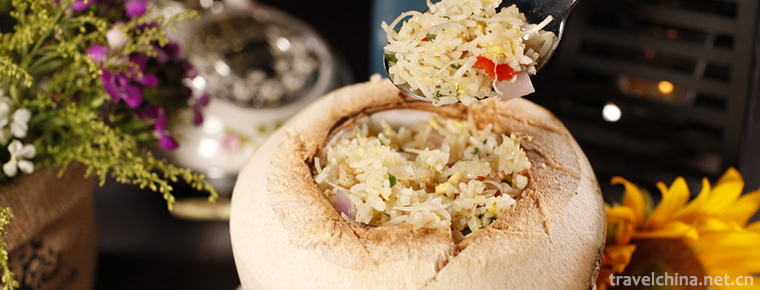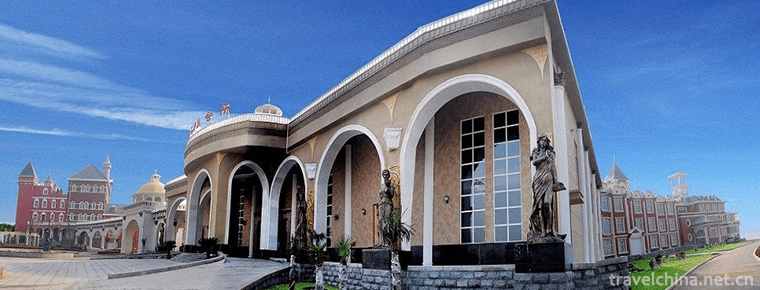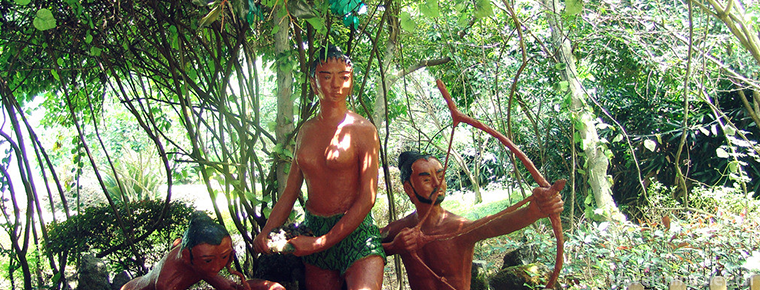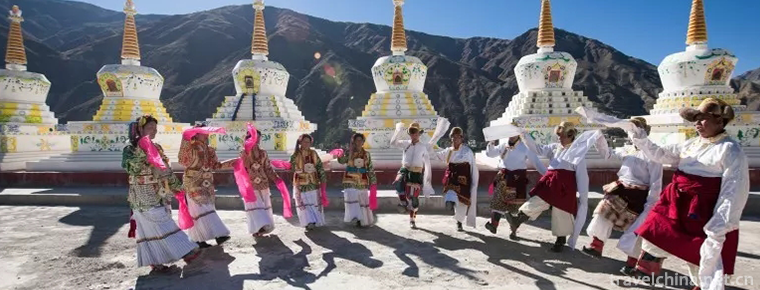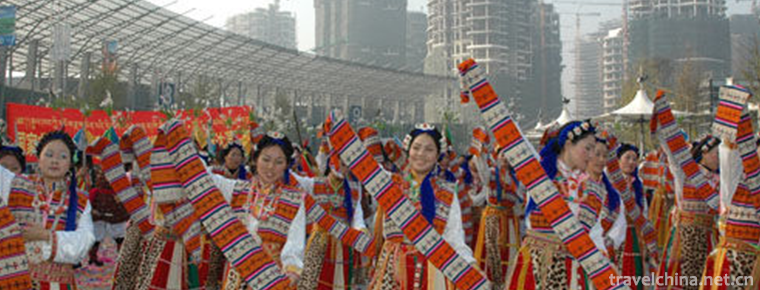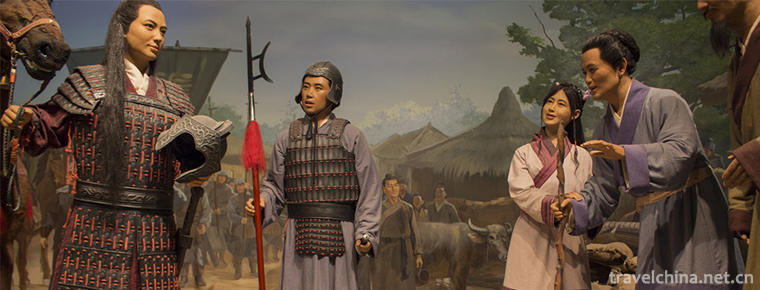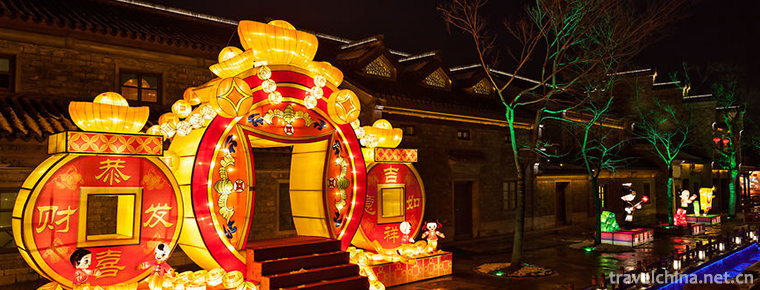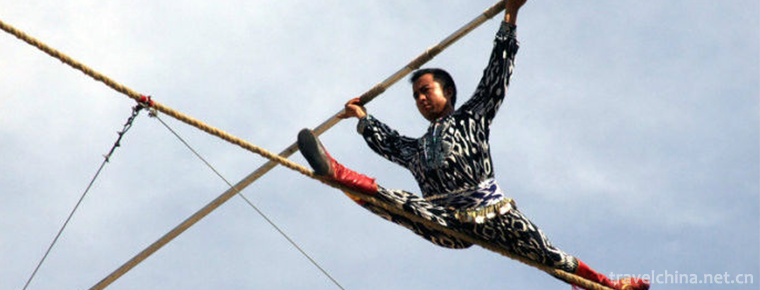Zuoquan Xiaohua Opera
Zuoquan Xiaohua Opera
Zuoquan Xiaohua Opera is a kind of Han folk song and dance drama which originated in Zuoquan County of Shanxi Province and spread in Yushe and Heshun areas near Zuoquan County. Its style is: one step three knees to tremble, ups and downs like waves, lightweight and smart twist swing, twist body rotation arm circle, shake fans such as butterfly dance, charm to move at will.
When Zuoquan Xiaohua Opera (literary society fire) originated in the early Ming Dynasty or between Song and Yuan Dynasty, it was formed in the Qing Dynasty and prevailed in Liao County in the late Qing Dynasty. During the Anti-Japanese War, "Wen She Huo" was gradually replaced by "Xiaohua Opera". After Liao County changed its name to Zuoquan County, "Xiaohua Opera" was called "Zuoquan Xiaohua Opera". Zuoquan County was also named "the country of folk art".
On November 11, 2014, Zuoquan Xiaohua Opera successfully declared as the fourth batch of national intangible cultural heritage.
Legend of Origin
The origin of Xiaohua Opera has not been documented so far. Therefore, we can only provide some textual research materials from the following aspects.
Old "Liaozhou Chronicle" contains: every Lantern Festival, the streets and alleys are lit at the head; at night, men and women in the village under the "social fire" in front of the line, walking through the streets and alleys, known as "walking all diseases", have the meaning of eliminating disasters and praying for good luck.
During the reign of Zhengde in Ming Dynasty (1506-1521), there was a passage of "social fire" in the chronicles of the Ming Dynasty, which was also recorded in the editions of Kangxi, Yongzheng, Guangxu and the Republic of China in the later Ming Dynasty. Thus, the emergence and formation of folk "social fire" was not later than the early Ming Dynasty or the earlier Song and Yuan Dynasties.
In the late Ming and early Qing Dynasties, there were more than 20 traditional programs on "social fire" in some villages. From this point of view, the formation of "social fire" should have a fairly long evolution process.
In 1940, the Shanxi-Hebei-Shandong-Henan Border Region Government organized personnel to conduct a one-year survey of Liao County's society, in which the report on culture said: "Before 1937, folk associations were widespread in urban and rural areas, with one village, one community, and one village, several associations. Every Lantern Festival, the head of the community leads villagers to burn incense in the temple, and organizes Wen and Wushu fires to perform in front of the temple, and then activities in the streets. This information, on the one hand, continues the records of "social fire" in the chronicles of the past dynasties, on the other hand, points out that "social fire" is composed of "cultural social fire" and "martial arts social fire".
According to Wang Changjiang, an old folk artist, who was born in 1909, Kong Jiazhuang is famous for setting up "social fires" in Liao County. He has been playing "social fires" in the village since childhood and every year in January. At that time, the main performances were sleepiness, childbearing, garden tour, prostitute complaint, shoveling vegetables and so on. There were more than twenty popular performances. The roles were divided into different roles, Dan and ugly, all played by boys, with colorful fans and twisting and singing. The memories of several other old artists in the county are roughly the same as those mentioned above.
According to the research data of Xiaohua Opera, at the beginning of the Anti-Japanese War in 1937, "Xiaohua Opera" was still called "Wenshe Fire", and many small plays with dramatic plots were retained. In addition to the previous ones, there were also "Aunt Aunt Aunt Aunt Aunt Aunt Aunt" and "Kidnapping Aunt", "Sending Aunt Aunt", "Seeking Han" and "Dange", with different roles. Dandan, Ugly, dressed in costumes, basic dance steps and fans are 20 or 30 kinds, the main props are colored fans, colored silk and so on.
To sum up, "Xiaohua Opera" (literary society fire) originated in the early Ming Dynasty or between Song and Yuan Dynasty, formed in the Qing Dynasty, and prevailed in Liao County in the late Qing Dynasty. During the Anti-Japanese War, "Wen She Huo" was gradually replaced by "Xiaohua Opera". After Liao County changed its name to Zuoquan County, "Xiaohua Opera" was called "Zuoquan Xiaohua Opera".
Dance content
Repertoire tunes
Traditional repertoire
There are about fifty kinds of traditional operas retained by Zuoquan Xiaohua Opera, most of which are handed down orally and heartily from generation to generation. There are about fifty new dramas after liberation. Among them, the representative works of traditional dramas are "shoveling vegetables", "herding cattle", "sending aunts", "visiting the garden", "prostitutes'complaint", "beating cherries", "Dange", "selling vegetables", "selling flat food", "playing wife", "top lamp", "sleeping too", "bearing a child", "hair child", "Aunt Madame" and "Gold". Box hat, abduction, Aunt Two, Parachute Jumping, Doctor Ye, Nasha Man, Gang Tianhong, Tiny Tit Falling on a Stitch, etc. are mostly comedies reflecting civilian life. Their roles are mainly clowns and clowns, and their individual plays are clowns, clowns and clowns.
Performing music
The music system of Zuoquan Xiaohua Opera is composed of two types: repetition of single songs and combination of songs and cards. There are no fixed music norms, the composition of tunes is free and free, and the structure of music can be expanded and expanded according to the needs of content, which has great expressive force. The tunes of Xiaohua Opera originate from the popular Zuoquan folk songs, the most representative of which is the "minor" in folk songs, followed by the "big tune". Most of the programs are in the form of Lianqu, and there are also one opera and one opera. In the Lianqu, the interlude and the singing tune of the goalkeeper are combined to make the tune stretching and moving and full of mountain and country customs. Qupai is divided into Adagio, Medium Plate, Allegro and Scatter Plate. It mostly uses G mode, accompanied by 2/4 and 3/8 beats. The instruments include Suona, Sheng, flute, Banhu, Erhu and Lower Hu, and later added dulcimer, Cello and violin. Percussion instruments mainly include big drum, small drum, big gong, small gong, big hairpin, small hairpin, wooden fish, bell touching and so on. In the past, some hairpins and four tiles have been lost. With the development of the times, the music of Xiaohua Opera is constantly innovating. Some use the existing Zuoquan folk songs, and some use folk songs as the material for compilation. For example, the traditional opera Kite Flying originally had only one typical minor song, but 11 lyrics were sung repeatedly, which seemed monotonous and tedious. Later, it changed its form into a three-part style, with introductions, exit tunes and crossing doors, and also used the technique of transposition to make the color new. The tunes in Xiaohua Opera "Laundry" and "Peach Blossom, Red and Apricot Blossom, White" are adapted on the basis of the main tunes of the folk songs "Kind Eggs Washing Clothes in the River" and "Liu Mei Hiding Marriage", which are elegant, elegant and full of local flavor. It can be seen that folk songs and floret plays are connected in flesh and blood, you have me, I have you. Folk songs provide endless music resources for Xiaohua Opera. Xiaohua Opera also promotes and enriches the melodic color of folk songs. They complement each other and are inseparable.
The performance form of Zuo Quan's Xiaohua Opera is singing and dancing, singing and dancing, singing and expressing people by singing and expressing their feelings through dancing. It requires not only loud singing, flexible dancing, but also excellent performance. This highly comprehensive aesthetic requirement limits the Xiaohua Opera's origin to be too long, so the traditional Xiaohua Opera can not be too long. The length of the script is usually very short. Later, in order to meet the performance requirements of a slightly longer script, the singing method was reformed, and the singing methods of accompaniment, help singing and chorus were added.
Performing props
The performances of Zuoquan Xiaohua Opera are inseparable from fans. The performers on the stage, no matter men or women, old or young, have a fan in their hands at the end of their lives, and later develop into two fans for each person. The local proverb "Left power is a strange thing, fans sell fast in winter" vividly summarizes the popularity of fans in the performance of Xiaohua Opera. The role of fans in Xiaohua Opera is more unique than other props, which not only plays a decorative role, but also has a strong function and expressiveness. In addition to helping actors complete their actions, it has the significance of acting, it can also supplement the deficiencies of the image expressed by the actions, and become a continuation of the actions, an emphasis, and a beautification. 。 Fans in the play are also combined into many fans, and through a series of fans to express their feelings, complete the image of the actors.
Performing process
The custom of making Lantern Festival in Zuoquan area has lasted till now. Most villages watch lanterns on the night of the 14th or 17th, 15th or 16th day of the first lunar month. All kinds of social fires will participate in street performances. After the end of the Lantern watching, Xiaohua Opera will perform on stage for three consecutive nights, performing for nearly two hours every night. At the same time, the program should not be heavy. Reply. Sixteenth and seventeenth are performances of social fire exchanges between villages. Literary and artistic performances are held in eighteen counties and towns. They parade during the day and perform on temporary stages at night.
Before Zuoquan Xiaohua Opera is ready for its official performance, it is necessary to pay homage to the village temple first.
When visiting the temple, it is divided into two parts: sacrifice and performance. In the early morning of the 15th day of the first lunar month, the flower theatre team returned to the village temple to worship. There are three animals in the temple. The three animals in the sacrifice must be male; the horn of the cattle and horse must be complete; the pig must be black, and the sheep must be white). First, the head of the village enters the fragrance to the god, performing the ritual of three kneeling and nine tapping, then the flower troupe enters the fragrance in turn, and performs the ritual of three worship and nine tapping. After the sacrifice, Zuoquan Xiaohua Opera was performed in front of the temple. There will be a ceremony before the performance. Firstly, invite the deities and guards of honor from the hall, then open the way by Wushu fire, escort the deities and guards of honor to the performance venue. As soon as it arrives in the morning, there are three salutes and the performance begins. The road was opened by gongs and drums, and the honor guards went ahead. There were pairs of incense sticks, white tiger banners, dragon fans, Tiandi medals, golden melons, axes and chaotic gongs. Next came the deity tablet carried by the sedan chair under Huang Luo's umbrella, followed by the social fire brigade. After walking around the venue, he began to perform Zuoquan Xiaohua Opera. At this time, the performers of Xiaohua Opera performed heartily, and the people who watched it were also crowded and lively. After performing several classic small flower operas such as "Picking Pepper" and "Brother Building Road", the fire escort of the Wushu Society sent the deity's tablet and guard of honor back to the temple.
After the sacrificial performances, the flower theatre teams in the villages first performed door-to-door in their villages. When they arrive at a house, they will beat gongs and drums first. If the family wants to see the performance, they will open the door and welcome them in. If they don't want to see it, they will close the door. Then the flower Troupe will re-enter other houses. These small flower theatre teams usually perform two traditional programs. After the performance, the families watching the performances give the small flower theatre teams some tobacco and wine, peanuts and melon seeds. The flower theatre teams take things to say some happy and auspicious words and then go to other homes. In Zuoquan, they are called "family clusters". After visiting the villages, they went to the administrative institutions in the county town to perform, and these institutions would give cash to these flower troupes. At the end of the day, these flower troupes can earn a lot of money. When they return to the village, they divide the money equally among the performers.
artistic characteristics
Overview
Zuo Quan's Xiaohua Opera is summarized as "one little, two flowers, three plays".
From a popular point of view to grasp its characteristics. Young: The performers are young; the scripts are small and the performance time is short, usually between 5 minutes and 20 minutes; the performance venue is small, which originally means that during the "Wenshe Fire" period, the performers only performed in the street and in the courtyard. Today's Xiaohua Opera can be performed in a narrow space, but also to meet the needs of the large stage performance. Flower: refers to the dancer's changeable figure, lively and moving, color fans fluttering up and down, the whole stage effect is like a hundred flowers blooming, dazzling. Play: It has the basic elements of a small flower play, complete plot, lively and interesting language dialogue.
Manifestation
- Song and dance
According to the content of the lyrics, the performers of Zuoquan Xiaohua Opera are accompanied by symbolic dance movements. Many plays also have simple plots and characters. It is characterized by paying equal attention to singing and dancing, or paying more attention to dancing. Such as "Singing Cooperative", "Swinging", "Picking Pepper" and so on. This form of singing and dancing can also organize large dance teams with more characters. Accompanied by the band, they can make various dancing postures with neat footwork and changeable fans and participate in the parade performances of major festival programs.
- Song and Dance Opera
Zuo Quan's Xiaohua Opera has a complete plot and character personality, and has certain dramatic contradictions and conflicts, which constitute the form of Xiaohua Opera. However, it is still expressed by the dance movements of Xiaohua Opera. Its characteristics are that there are dances in songs, dances in dances, songs, dances and plays in close combination. The representative plays of this kind include "Beating Cherries", "Brother Vegetable", "Huailin Club" and so on. The above two forms have their own characteristics. "Therefore, they are loved by the masses, and have survived and developed.
Action
Dance action is the special performing means and core art of Zuoquan Xiaohua Opera, which is different from other singing and dancing operas. It is a special form of folk songs and dances between singing and dancing or national singing and dancing. After thousands of years of practice of artistic inheritance, a singing and dancing performance style with the basic characteristics of "three steps upside down" and "butterfly fan" has been formed.
Three steps
"Three steps upside down" is called one step upside down. The characteristics of step type are based on "cross step", that is to say, four points of the "ten" shape are the locating points of the landing step. It is similar to and different from the twisting Yangkobu type. Start with the left foot and move up to the front of the right foot. The heel first touches the ground and turns the forefoot into "two bumps", then triple bumps on the forefoot tip and triple bumps on the inside of the forefoot. Right foot forward, still three bumps. In the third shot, when the left foot is retracted to the left side and landed on the foot, it bounces up and down again. Fourth, take the right foot back to its original position. Continuous progress, step by step upside down, showing the trend of flying in the air.
Dancing fans
Fan is a typical prop of the song and dance art of Zuoquan Xiaohua Opera. There is no fan.
It can't be called "Fan Dance" because it can't be called "Zuoquan Xiaohua Opera". The power and change of dancing fans determine the artistic characteristics. Left-winners also call it "Fangong". They twist 180, 210, 270 or even 360 degrees with the fan axis as the center. The size of the angle and the speed of the frequency determine the artistic effect of fanflower. One-handed dancing fan: Various methods of dancing the fan with the right hand are common: butterfly fan, vertical fan, closing fan, opening fan, drifting fan, knocking fan, end fan, fanning, pushing fan, driving fan, piercing fan, big stroke, small stroke and so on. Hand Dancing Fan: Each hand holds one fan, and the two fans blossom endlessly. There are push-cloud fan, pull-out fan, wave fan, exploratory fan, swing fan, big-cloud hand, small-cloud hand, pairing flower, big-blossom, small-blossom, sunrise fan, shade fan and so on.
Basic movements
The basic "action" of Zuoquan Xiaohua Opera combines dance steps with dancing fans organically, with strict requirements on opponents, eyes, body and steps. The action of Zuoquan Xiaohua Opera is the singing and dancing vocabulary of Zuoquan Xiaohua Opera. In the book "Zuoquan Xiaohua Opera", a large number of Xiaohua Opera dance vocabulary are mentioned, such as combing hair, looking at the mirror, looking at flowers, windward, clouds chasing the moon, Erlong opera beads and so on, which are the organic combination of Fangong and footwork, up to 100 kinds. In traditional Xiaohua Opera, action is the language of dance, which shows character and image characteristics. Therefore, the action requirements of male and female protagonists are strictly defined. The man is generous, sharp and stretching, while the heroine is delicate, tender and graceful.
- Dancing momentum
Dancing momentum is the formation or appearance of the results of the changes in the dance action process of Zuoquan Xiaohua Opera.
It has a clear positioning of its opponents, eyes, body, law and steps, and expresses the cultural connotation of the established plot. Action is a process, a change, and momentum is a result. It comes from the process, expressing a complete "vocabulary" namely "appearance". It often appears at the end of a phrase or at the key point of the plot development. From dance steps, fan steps and movements, the final formation of "shape" is the result of a complete performance process of Zuoquan Xiaohua Opera Dance vocabulary. It differs from the action of Zuoquan Xiaohua Opera in that the action is repetitive and changeable, and dances according to a certain rhythm, while the gesture of Zha is a definite set given by the change of dance posture, and it is static. It usually stops at the end of the phrase, and some extend to four beats, which is a full display of the dancing of the characters'inner heart. Zuoquan Xiaohua Opera "Zha Shi" has a single, double, many people; there are groups of Zha Shi. A person's vigor is very rich, such as: watchman, looking forward to return, wearing the sky, shy, cheating, Golden Chicken independence, peacock open screen, prodigal son back, full of stars, flying over the sky, springing back, and so on. The "Zha Shi" of Zuoquan Xiaohua Opera is the result of the combination of dance steps, fans and gestures, and it is rich and colorful. Because of the changeable steps and various movements of Zuoquan Xiaohua Opera, Zha Shi does not stick to one pattern.
Dynamic characteristics
The dynamic characteristics of Zuoquan Xiaohua Opera are as follows: one step, three knees shaking, ups and downs like waves, light and agile swinging, twisting and turning arms round, shaking colorful fans like butterfly dance, and the charm should move at will.
Lightweight and cheerful lower body rhythm
"Three Bumps" is the most representative lower body rhythm in Xiaohua Opera dance.
Including the basic elements of tremor, bump, jump, pedal, focusing on the rhythm of the knee and ankle joint, each leg and foot have the corresponding breathing and extension. The whole step should be propelled from the sole of the foot, wrist and knee, while the slow step should be controlled effectively. At the same time, it is necessary to coordinate with the high difficulty of lifting the power leg back down and sliding out slowly from the heel. With the bouncing elasticity, the knees flex and stretch rhythmically, making the whole body form obvious undulations, like a boat in the waves, leisurely and comfortable. This step is unique in Chinese folk dance, enriches the content of Chinese folk dance steps, and its training value is also unique.
Stretching and Beautiful Upper Body Dance
"Twisting" is the main part of the performing art of Zuoquan Xiaohua Opera, which is more difficult than ordinary Yangge Twisting. Therefore, the masses call it Twisting Flower Opera. With the postures of twisting, shaking head, rounding arms, twisting shoulders and three bends, the dancing features of Xiaohua Opera are stretching, vigorous, simple and handsome. Among them, I think the "three bends" posture is the most distinctive. It takes the top of the head, buttocks and knees of the body to form the "S" posture. With all kinds of brisk steps under the feet, it is flexible and lovely, which reflects the feminine tenderness and cleverness. There are more than 50 dancing styles in Xiaohua Opera, which have strong image sense. Women have magpies climbing plums, looking back at the moon, mandarin ducks playing water, swallow spreading wings and Golden Chicken independence. Men have horse riding, crouching crotch, phoenix spreading wings, sea drawing, bow and arrow, etc. Nowadays, many popular dance moves have been absorbed into the dance of Zuoquan Xiaohua Opera, which makes Zuoquan Xiaohua Opera more vigorous.
The Use of Variable Projects in Flying Dance
Zuoquan Xiaohua Opera adopts the characteristic prop of double color fans.
Various applied techniques of color fans are called fangong. There are more than 50 kinds of fans, among which "butterfly fan", "scattering fan", "knocking fan", "fan", "turning fan", "turning fan" and so on are the main ones. These fans have very strong uniqueness, which is different from the fans of folk dances of other nationalities and have better training value. Especially the unique "butterfly fan" requires performers to clamp the fan with both hands and swing their arms with elbows. At the same time, the fan flower is flipped up and down by swinging the fan flower with wrist as the axis. It gives people the feeling of butterfly flying, so it is called "butterfly fan". Fan is the universal prop of Xiaohua Opera. It can be transformed into various daily necessities in the hands of actors. It is also an important tool for expressing thoughts and feelings. The opening, closing, turning, moving, static, fast and slow of fan convey the joy, sorrow and warm joy of dance.
Plain and enthusiastic performance style
In the long process of historical development, Zuoquan Xiaohua Opera experienced the baptism of different periods, but also created its performance style keeping pace with the times. Whether it is the vigorous Xiaohua Opera in the war years or the relaxed and happy Xiaohua Opera in the peacetime, it has its unique expressive force and appeal. In emotional expression, sometimes enthusiastic and unrestrained, sometimes quiet and restrained, from the rhythm of dance is implicit and simple, but from fan props and emotional expression is warm and passionate. This requires actors to be not only physically harmonious and beautiful, but also emotionally full. Many of the classics of Xiaohua Opera are of certain dramatic color. It is necessary to show the contradiction and conflict of drama from the plot and personality of the characters. There are dances in songs, dances in plays, songs, dances and plays in close combination.
Distribution Range
Zuoquan Xiaohua Opera is a kind of song and dance drama which originated in Zuoquan County of Shanxi Province and spread in Yushe and Heshun parts of Zuoquan County and its vicinity. Among them, Liulin Township, Shixiang Township, Hanwang Township and Baoze Township in the West and north of Zuoquan County are the main distributors. The representative villages are Confucius, Jiangjiazhuang, Liulin, Dalin, Sujiapo, Temple Immortals, Linhe, Shanghai, stables, stone caskets, Sanjiacun, Lion Rim, Xiaohui, Qilidian, Xihetou, Fengpaoyu, Chengguan, Wulihou, Tudi, Longqiao, Caojiazhai, Caojiagou, Fengyuan, Jiahui, Dalingpo, Xiaoaoao, Fengpao. Shuiheng, Shigang, Xiaqizhi, Shangqizhi, Dianshang, Pingwang and Hanwang are more than 30 villages. Among them, Kongjiazhuang Xiaohua Opera in Liulin Township is famous for its excellent performers during the War of Resistance Against Japan. It has a great influence in Fangyuan area.
representative figure
A group of successors of Zuoquan Xiaohua Opera were trained in Zuoquan County, Shanxi Province, such as Liu Jianyu, Ji Aifang, Shi Zhanming, Li Mingzhen, Li Guisuo, Li Mingfang and Liu Yu.
Li Mingzhen, National Inheritor of Intangible Cultural Heritage
Li Mingzhen participated in the compilation of Zuoquan Xiaohua Opera materials in 1964. Among them, 21 dancing steps were represented by "three strides", 45 by "butterfly fan", and 33 by "mirror gesture", which were illustrated and photographed by her and edited by Jinzhong Education Bureau. This is the first time that the dance movements of Zuoquan Xiaohua Opera have been classified, named and printed in a book. In 1982, she participated in the compilation of Zuoquan Xiaohua Opera reference book organized by Jinzhong Mass Art Museum, and published 56 dance movements for her demonstration photographs. In 1992, she compiled "Shanxi Folk Dance - Zuoquan Xiaohua Opera", which provided a unique role for the inheritance and protection of the national intangible cultural heritage "Zuoquan Xiaohua Opera", and also provided a reliable text for scholars who are keen on folk dance research in China.
Meaning Value
Zuo Quan's Xiaohua Opera has developed from the local folk songs and performances to the present from the past "communal fires" and gradually extended to be well-known both inside and outside the province and even at home and abroad. Zuoquan folk song Xiaohua Opera has created an excellent artistic atmosphere and humanistic environment for the reform, opening up and economic development of Zuoquan. Xiaohua Opera, which shines with the wisdom of the left-right people, is a wonderful flower in the great garden of art of the motherland, and its value will be forever recorded in the annals of history.
Zuoquan Xiaohua Opera is a living fossil of Shanxi folk art. At present, the artistic form and culture of the stage beauty of Xiaohua Opera dance are closely related to Shanxi local culture, humanistic spirit and traditional artistic temperament. In the contemporary Chinese dance industry, the introduction and penetration of advanced concepts at home and abroad have enriched and diversified the dance. At the same time, all kinds of original ecological small-area dances of our nation have been impacted unprecedentedly. It is urgent to protect and develop the Chinese folk dance art. Let us take the essence of traditional culture as the foundation and the aesthetic changes of the times as the guide to better inherit and carry forward the national culture, so that people can better and more comprehensively understand the Chinese national folk culture and art.
Inheritance and Protection
In the late Qing Dynasty, Zuoquan Xiaohua Opera absorbed a large number of folk minor tunes and added simple story plots. The characters also developed from the original third person to the first person form of Fengsheng, Dan, Ugly and other acts. It gradually developed into a local opera of singing and dancing. The repertoire of the opera was "selling flat food" and "flying kites". 》 "Viewing the Lamp", "Scraping Vegetables", "Playing Cherries" and so on.
During the Anti-Japanese War, Zuoquan County was the base area behind the enemy. With this form of literature and art, the anti-Japanese revolutionary government propagated the masses, organized the masses to fight against Japan, made use of, reformed and improved the Zuoquan Xiaohua Opera, named this fixed form of literary and artistic activities "Zuoquan Xiaohua Opera", and Xiaohua Opera really began to become a comparison. Complete form of stage opera. His works and performances, such as Sending Brothers to the Army, Defending Huangyan Cave, Little Cattle, Winter School, Returning to Mother's Home and Four Seasons Production, reflect the struggling life at that time. They have become powerful weapons for educating the people, encouraging morale and attacking the enemy.
In 1954, Wang Quanzi and Wang Lianzi, artists of flower opera, performed the traditional little flower opera "Selling Flat Food" and participated in the first national folk art performance, which was well received.
In June 1958, Zuoquan County set up the "Zuoquan County Red Flag Opera Troupe" and put on many flower dramas.
In 1996, Zuoquan County established the Xiaohua Opera Art Troupe.
In 2006, Zuoquan County successively established the Zuoquan Folk Song Xiaohua Opera Research Association and the Zuoquan Folk Song Xiaohua Opera Protection Center; organized the successors through "pass on, help, belt" rehearsal of "Daqiuxian", "transplanting rice seedlings", "kite flying", "picking pepper" and "making military shoes" and other fine traditional small flower operas; inherited and innovatively held.“ Cultural activities such as Cultural Activities Month, Social Fire Festival, Left Quan Folk Songs Singing, Urban and Rural Literary and Art Exquisite Programs Performance, Fire Tray Folk Custom Activities, etc., have been extensively participated in. The three-year Left Quan Folk Songs and Xiaohua Opera Grand Prix has been held for three consecutive years, and "Peach Blossom, Apricot Blossom White Songs Collection" and "Shizhan" have been published and issued. Ming album, Ji Aifang album and other CD-ROMs.
In June 2006, approved by the State Council and promulgated by the Ministry of Culture, "Blooming Diao" 11 was listed as the top record music category of the national intangible cultural heritage protection name.
In 2008, the county implemented the Zuoquan Folk Songs and Xiaohua Opera Classroom Project in an all-round way. In the past seven years, more than 63,000 books of Zuoquan Folk Songs and Xiaohua Opera local textbooks have been printed and distributed free to primary and secondary schools in the county, benefiting more than 60,000 students.
In 2008, Zuoquan Xiaohua Opera was listed in the provincial intangible cultural heritage list.
In November 2014, Zuoquan Xiaohua Opera was selected into the national intangible cultural heritage protection list.

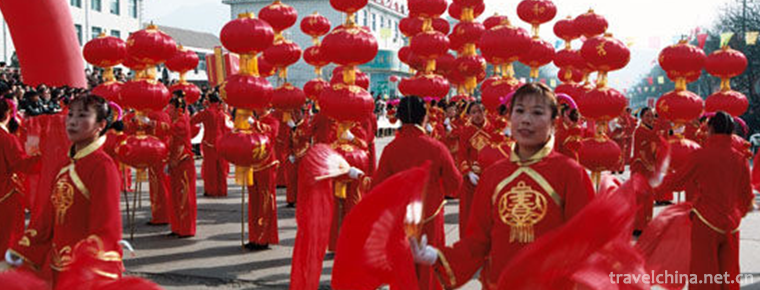
-
Coconut rice
"Coconut rice", also known as coconut boat, belongs to Hainan cuisine. Coconut is very nutritious and is a good product for both medicine and food. .
Views: 239 Time 2018-11-05 -
Hanover Manor
Hannuo Manor is a national AAAA-level tourist attraction, located in the southeast suburbs of Shanting District, Zaozhuang City, Shandong Province. It is located on the front alluvial slope surrounded.
Views: 105 Time 2019-01-13 -
Totem Road
The ancient totem road is located in Yangshuo's famous "Shili Gallery". Not far from Guilin, the scenic spot exhibits primitive life scenes such as stone tools, pottery, natural totem pillar.
Views: 144 Time 2019-02-22 -
Ba Shan Bei Er Song
Bashan Beibei Song refers to a traditional folk song which was produced and spread in the area under the jurisdiction of Bazhong City at the southern foot of Micang Mountain in northeastern Sichuan Pr.
Views: 279 Time 2019-04-03 -
De rong xue qiang
Derong Xueqiang is a folk dance popular in Waka Township, Derong County, Ganzi Prefecture. Its movements are strong, simple and generous, its next steps are strong and its feet are crisp.
Views: 197 Time 2019-04-26 -
Castawin Dance
Castawin Dance, a traditional dance in Heishui County, Sichuan Province, is one of the national intangible cultural heritage..
Views: 191 Time 2019-05-08 -
Mulan Legend Hua Mulan Legend
Mulan legend is one of the Chinese folklores. Mulan legend began in Sui and Tang Dynasty. It is characterized by the spread of Chinese folk oral language in the early period, and then by the appearanc.
Views: 120 Time 2019-06-06 -
Qinhuai Lantern Festival
Qinhuai Lantern Festival, also known as Jinling Lantern Festival and Confucius Temple Lantern Festival, is a popular folk cultural activity in Nanjing. It is mainly held from Spring Festival to Lanter.
Views: 148 Time 2019-06-10 -
Uygur Dawazi
Dawazi is an ancient traditional acrobatic performing art of the Uygur people. "Da" means "hanging" in Uyghur, and "Wazi" means someone who likes to do something. The wor.
Views: 86 Time 2019-06-26 -
Thousand Buddha Cliffside Sculptures
Qianfo cliff, located 4 kilometers north of Guangyuan City, on the East Bank of Jialing River and on the ancient Shu Road of Jinniu, has a long history and exquisite carving skills. The grottoes began in the late Northern Wei Dynasty, flourished in the Tang Dynasty and ended in the Qing Dynasty. After thousands of years.
Views: 340 Time 2020-11-08 -
Video of Chengdu Giant Panda Base
It has been said to take the children to Chengdu Giant panda base to play, but because the new coronavirus epidemic did not go.
Views: 353 Time 2020-12-13 -
Panzhihua before Sui Dynasty
Archaeological discoveries have proved that Panzhihua is one of the areas where human activities took place earlier. In addition to the "Yuanmou Man" and "Butterfly Man" relics found in nearby areas, the huilongdong ancient human site about 18000-12000 years ago has been found in Panzhihua City..
Views: 114 Time 2020-12-14
